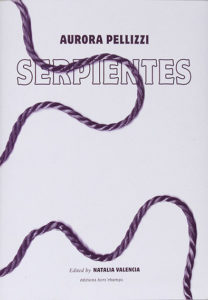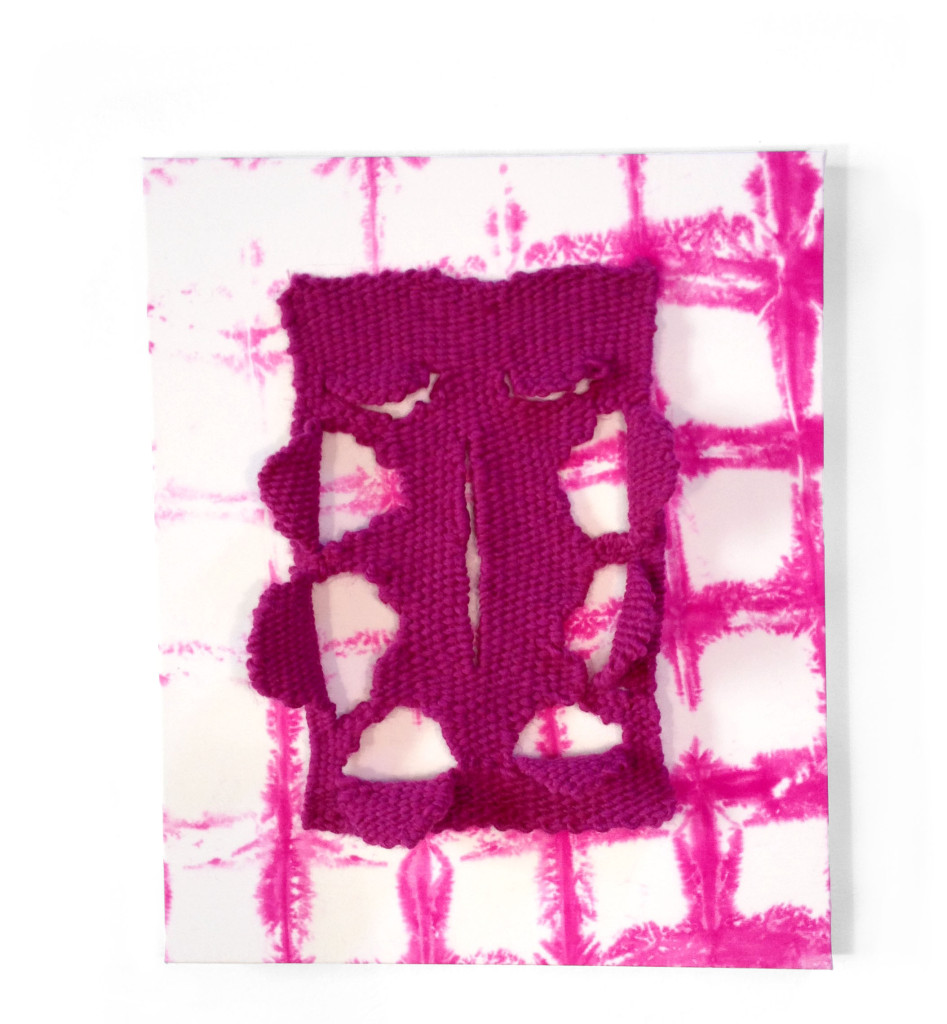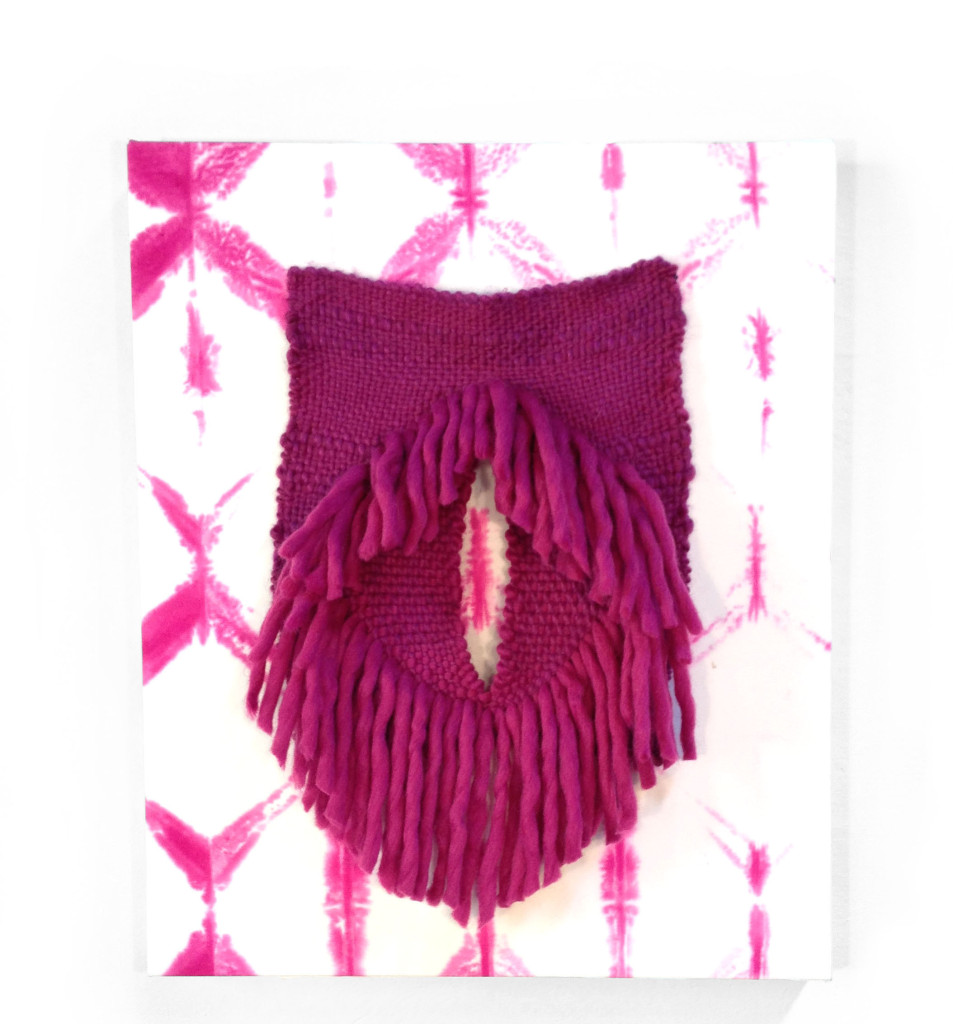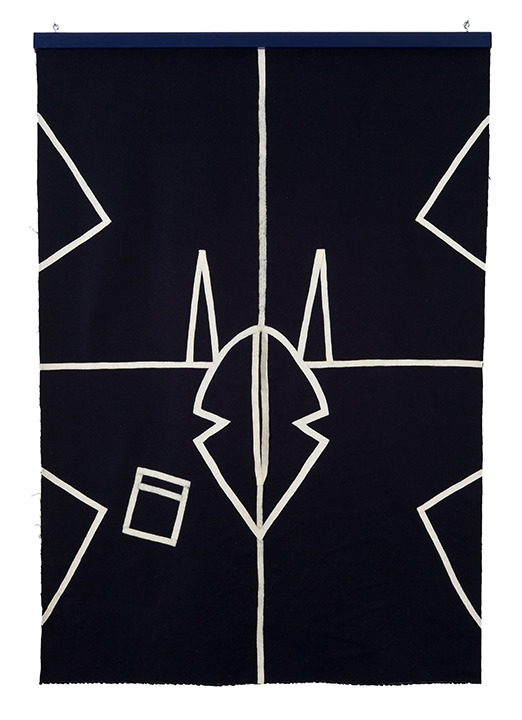- Pariendo Poncho
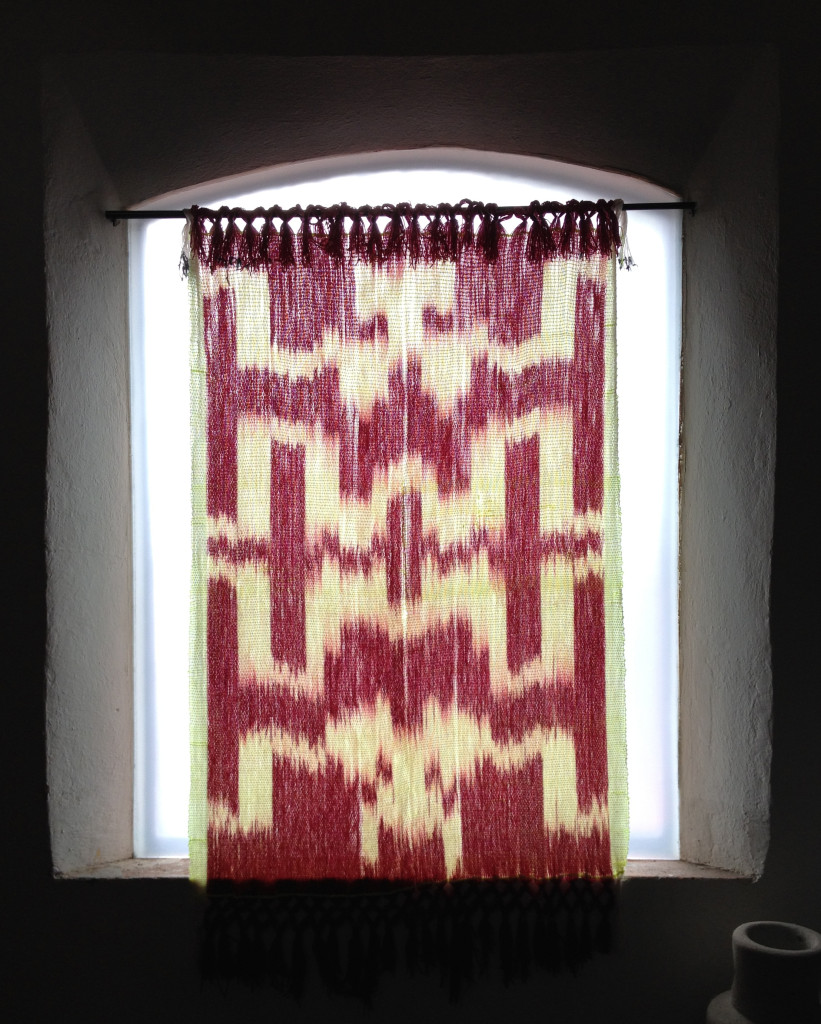
Pariendo Poncho, ikat cochineal-dyed wool, 2014
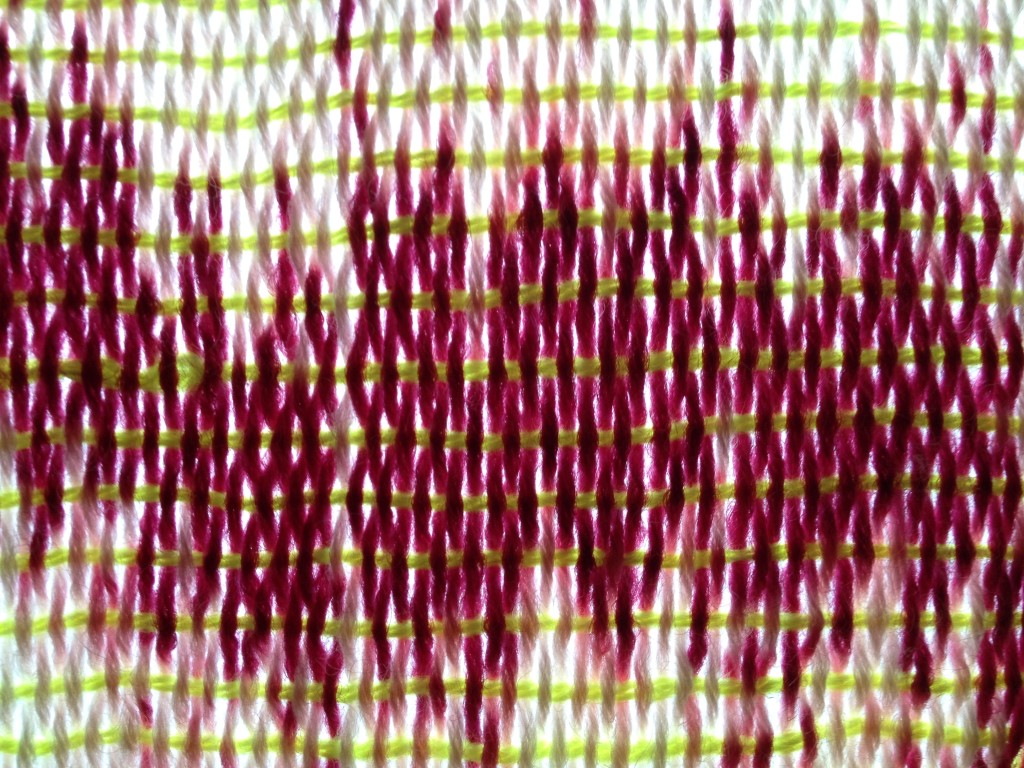
(Detail) Pariendo Poncho, ikat cochineal-dyed wool, 2014
This piece was ikat-dyed with cochineal on the warp threads and handwoven on a four-harness pedal loom. The weft is neon green acrylic thread. It was woven in double-cloth, leaving an opening in the center, in the way ponchos and sarapes are made.
Ikat is a resist dyeing process in which some areas of threads are bound before dyeing, protecting them from dye, so that when uncovered they retain the original color of the yarn. In this piece shapes were bound onto the warp threads before dyeing so that in the final piece white un-dyed figures appear on a cochineal-dyed ground.
The white shapes represent two mirrored female figures in squatting positions. The opening in the weaving, where the head would come through in the poncho, coincides with the genital areas of the figures represented, simulating a sort of birth process where the double figures give birth to the person wearing the poncho.
In the weaving process the ikat shape shifts slightly, rendering the image less geometric. The image appears slightly out of focus because the edges and borders become blurred. This process evokes movement and references the liquid aspect of the natural-dyeing process.
Continue reading → - PARIENDO PONCHITO
 Continue reading →
Continue reading →Pariendo Ponchito, 2014, cochineal-dyed handwoven wool, 55 x 80 cm.
This piece is a smaller version of Pariendo Poncho, except that the image is inverted, so that the figure appears with red cochineal, while the ground remains white. Pariendo Ponchito was ikat-dyed with cochineal on the warp threads and handwoven on a four-harness pedal loom. The weft is un-dyed wool thread. It was woven in double-cloth, leaving an opening in the center, in the way ponchos and sarapes are made.
Ikat is a resist dyeing process in which some areas of threads are bound before dyeing, protecting them from dye, so that when uncovered they retain the original color of the yarn. In this piece shapes were bound onto the warp threads before dyeing so that in the final piece cochineal read figures appear on a white ground.
The white shapes represent two mirrored female figures in squatting positions. The opening in the weaving, where the head would come through in the poncho, coincides with the genital areas of the figures represented, simulating a sort of birth process where the double figures give birth to the person wearing the poncho.
In the weaving process the ikat shape shifts slightly, rendering the image less geometric. The image appears slightly out of focus because the edges and borders become blurred. This process evokes movement and references the liquid aspect of the natural-dyeing process.
- LUPE
 Lupe, 2014, acrylic felt on wood bars, 150 x 80 cm.Continue reading →
Lupe, 2014, acrylic felt on wood bars, 150 x 80 cm.Continue reading →This piece is made out of industrial felt stretched onto stretcher bars. The acrylic felt material is used in Mexican folkloric crafts and costumes. The color, typically described as rosa mexicano, is feminine, folkloric, and kitsch.
Semi-circular slits cut into the fabric create shapes and flaps that reference the image of the Virgen of Guadalupe. Lupe is a commonly used abbreviation for the name Guadalupe. The scalloped almond shape of the religious image is often used in representations of the Virgin. The shape also references the body, particularly the female sexual organ, presenting a collapse between sexual and spiritual imagery.
- LUPITA
- BARBAROSA
- PUSSIKAT
 Pussikat, 2014, cochineal-dyed handwoven cotton on cochineal-dyed silk, 45 x 40 cm.Continue reading →
Pussikat, 2014, cochineal-dyed handwoven cotton on cochineal-dyed silk, 45 x 40 cm.Continue reading →This piece is made with cotton warp threads cochineal-dyed with ikat technique, woven together with cochineal-dyed weft threads. An un-dyed mercerized Egyptian cotton is woven into the cloth as a supplementary weft. This piece was woven on a backstrap loom. The hand-woven cloth was sewn onto a silk fabric dyed with cochineal in nui shibori technique and consecutively stretched onto stretcher bars.
Ikat is a resist dyeing process in which some areas of threads are bound before dyeing, protecting them from dye, so that when uncovered they retain the original color of the yarn. In this piece, the un-dyed sections of thread reveal a white diamond shape. In the weaving process the threads tend to shift, creating a more irregular shape.
Supplementary weft threads form another more geometrically defined diamond within. They frame a slit woven into the center of the piece and their loose ends form a fringe that reaches out past the edge.
This piece is subtly hued and the softness and delicacy of the materials, along with the geometric balance create a quiet, contemplative space; while the slit, the shapes, the pinks, and the fringe reference skin and female sexual organs.
Nui shibori is another resist dyeing technique in which fabric is tightly stitched to prevent dye from reaching all areas of the fabric. The shibori dyed edge on this piece is only slightly visible from the front. The veined edge eats away at the rectangular shape of the object making it appear irregular. A side view of the piece reveals the entire ribbed edge of the fabric, providing an alternate experience when viewed from the side.
Although this piece integrates several textile traditions, this particular use of supplementary weft with cotton thread, derives from techniques employed in the weaving community of San Bartolo Yautepec, Oaxaca, Mexico.
- SOFT BLACK TRIANGULO
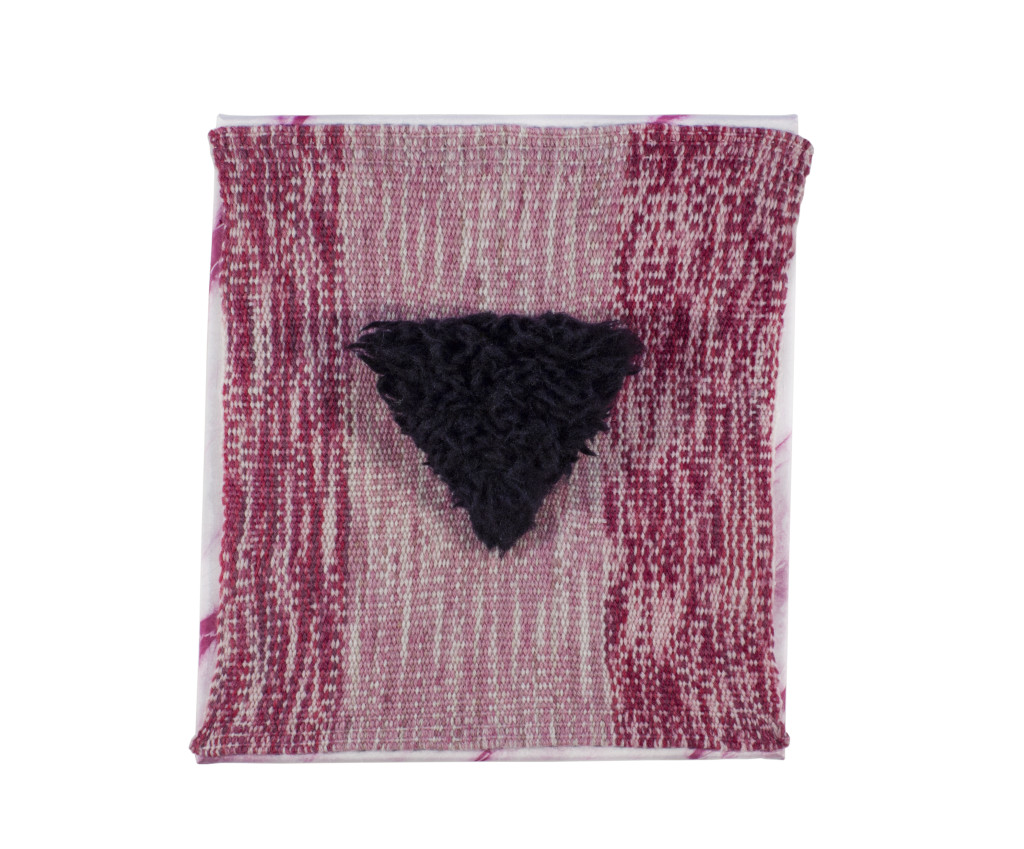
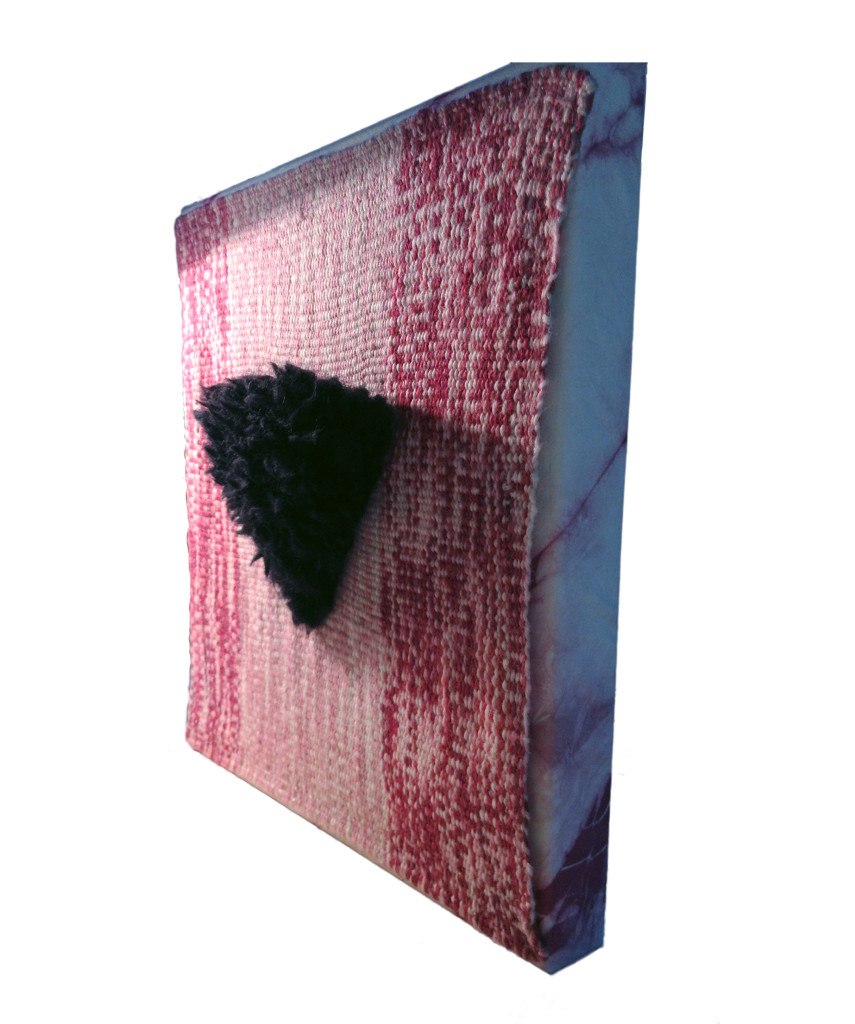 Continue reading →
Continue reading →Soft Black Triangulo, 2014, cochineal-dyed handwoven wool on cochineal-dyed silk, 57 x 41 cm.
This piece was woven on a back-strap loom. The wool warp threads were ikat-dyed with cochineal. The woven cloth is sewn onto silk fabric dyed using an arashi shibori technique with cochineal and subsequently stretched onto wooden stretcher bars.
Weaving black fibers into the cloth with ghiordes knots, a Turkish rug making knot, created the central triangular shape. This method of piling produces a volume that projects outward from the woven plane. The triangular shape forms a structure that allows the threads to become progressively longer as they move upward, making the top part of the triangle extend the furthest away from the supporting surface.
The triangular shape evokes pubic hair, while the pinks and reds of the cochineal in the ground evoke flesh and blood. The change in texture and light between the shine of the silk and the warmth of the wool, the pinks, reds and blacks create a soft contrast in tones. This piece is made with delicate materials, but it stands in bold affirmation of the female body and sexuality, as well as of the often-discredited textile crafts relegated to women.
- PONCHO
- GREENSCREEN PONCHO
Greenscreen_Poncho_01, 2009, NTSC Video loop
Greenscreen_Poncho_01 is a floor to ceiling video projection. The video image has been ‘masked’ so that an uneven rectangle of light is projected in the shape of a draped undulating green fabric with a slit down the center.
The green color references greenscreen, which is a technique used in video editing. Generally, actors are set to perform in front of the greenscreen, so that later, in the editing process, the green color can be ‘keyed’ out and the entire background can be replaced with different footage.
In this video, I have ‘keyed’ out everything but the swaying green cloth. The cloth becomes the actor appearing to express some kind of gesture and life in its movements. What is traditionally considered the ‘ground’ is treated as the ‘subject’, a dichotomy often referenced in painting as the ‘figure-ground’ problem.
There is a slit down the center that references ponchos. This breaks the plane and makes the fabric evoke the body. Not only is the fabric perceived more tactually, but it also evokes the female sexual organ; feminizing a traditionally un-feminine garment and the digital technology that made it possible.
Continue reading →
